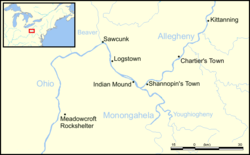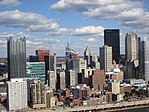This article needs additional citations for verification. (February 2021) |
Western Pennsylvania | |
|---|---|
 Indigenous American villages were located throughout Western Pennsylvania. Kittanning still uses its Indigenous name, while the town of Sawcunk lies on the site of present-day Rochester, Pennsylvania. | |
| Coordinates: 41°03′N 79°03′W / 41.05°N 79.05°W | |
| Country | United States |
| Commonwealth | Pennsylvania |
| Largest city | Pittsburgh |
| Other cities | List |
| Area | |
| • Total | 20,363 sq mi (52,740 km2) |
| • Land | 19,412 sq mi (50,280 km2) |
| • Water | 951 sq mi (2,460 km2) 4.67% |
| Population (2020 Census) | |
| • Total | 3,753,944 |
| • Density | 193.38/sq mi (74.66/km2) |
| Time zone | UTC-5 (ET) |
| • Summer (DST) | UTC-4 (EDT) |
Western Pennsylvania is a region in the Commonwealth of Pennsylvania encompassing the western half of the state. Pittsburgh is the region's principal city, with a metropolitan area population of about 2.4 million people, and serves as its economic and cultural center. Erie, Altoona, and Johnstown are its other metropolitan centers. As of the 2010 census, Western Pennsylvania's total population is nearly 4 million.[1]
Although the Commonwealth does not designate Western Pennsylvania as an official region, since colonial times it has retained a distinct identity not only because of its geographical distance from Philadelphia, the beginning of Pennsylvania settlement, but also and especially because of its topographical separation from the east by virtue of the Appalachian Mountains, which characterize much of the western region. The strong cultural identity of Western Pennsylvania is reinforced by the state supreme court holding sessions in Pittsburgh, in addition to Harrisburg and Philadelphia.



